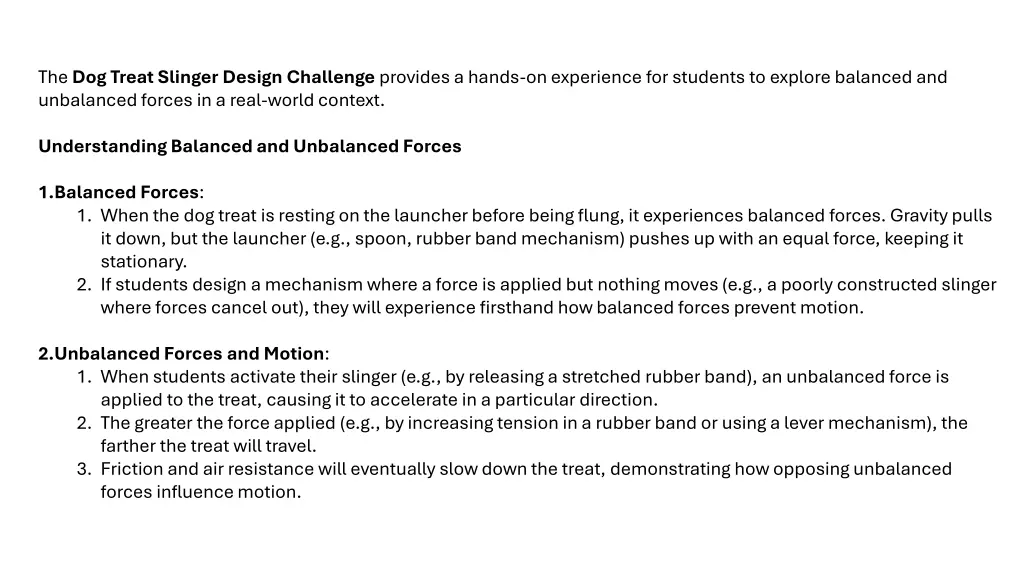
Exploring Balanced and Unbalanced Forces in Dog Treat Slinger Design Challenge
"Experience hands-on activities exploring forces with the Dog Treat Slinger Design Challenge. Understand balanced forces at rest and unbalanced forces in motion. Engage in engineering design, Newton's laws application, and math integration for a comprehensive learning experience."
Download Presentation

Please find below an Image/Link to download the presentation.
The content on the website is provided AS IS for your information and personal use only. It may not be sold, licensed, or shared on other websites without obtaining consent from the author. If you encounter any issues during the download, it is possible that the publisher has removed the file from their server.
You are allowed to download the files provided on this website for personal or commercial use, subject to the condition that they are used lawfully. All files are the property of their respective owners.
The content on the website is provided AS IS for your information and personal use only. It may not be sold, licensed, or shared on other websites without obtaining consent from the author.
E N D
Presentation Transcript
The Dog Treat Slinger Design Challenge provides a hands-on experience for students to explore balanced and unbalanced forces in a real-world context. Understanding Balanced and Unbalanced Forces 1.Balanced Forces: 1. When the dog treat is resting on the launcher before being flung, it experiences balanced forces. Gravity pulls it down, but the launcher (e.g., spoon, rubber band mechanism) pushes up with an equal force, keeping it stationary. 2. If students design a mechanism where a force is applied but nothing moves (e.g., a poorly constructed slinger where forces cancel out), they will experience firsthand how balanced forces prevent motion. 2.Unbalanced Forces and Motion: 1. When students activate their slinger (e.g., by releasing a stretched rubber band), an unbalanced force is applied to the treat, causing it to accelerate in a particular direction. 2. The greater the force applied (e.g., by increasing tension in a rubber band or using a lever mechanism), the farther the treat will travel. 3. Friction and air resistance will eventually slow down the treat, demonstrating how opposing unbalanced forces influence motion.
Engineering Design and Experimentation Trial and Error: Students will test different designs and observe how varying forces (e.g., different rubber band strengths, lever lengths) affect the distance of the launched treat. Data Collection and Predictions: By recording how far their treat travels and creating a line plot, they can identify patterns and predict future motion. Iterative Improvements: Observing when their launcher fails (e.g., not enough force or too much resistance) helps students refine their understanding of how forces interact. Scaling for Older Grades - students will develop a concrete understanding of how balanced and unbalanced forces affect motion, strengthening their ability to analyze and predict force-related interactions in everyday life. Newton s Laws in Action Newton s First Law (Inertia): The treat remains at rest until an unbalanced force propels it forward. Newton s Second Law (F = ma): The force applied by the launcher affects the acceleration of the treat, helping students see how stronger forces result in farther launches. Newton s Third Law (Action-Reaction): As the launcher pushes the treat forward, the treat exerts an equal and opposite force on the launcher.
The Dog Treat Slinger Design Challenge integrates math through measurement, data collection, financial literacy, and graphical representation, helping students develop key mathematical skills. Measurement & Data Analysis 1. Measuring Distances 1. Students will use rulers or measuring tapes to record how far their dog treat is launched. 2. They will measure in inches, using halves and quarters, aligning with the 3rd-grade math standard (AR.Math.Content.3.MD.B.4) for measuring lengths with fractional units. 2. Creating a Line Plot 1. After multiple trials, students will plot their data on a line plot, marking distances along a number line. 2. This allows them to visually compare different launch distances and recognize patterns in their results.
Data Interpretation & Predictions Identifying Trends: Students will analyze their line plot to determine: Which design features resulted in longer launches? How much variation exists between trials? Using Data to Make Predictions: By identifying the range and average of their launch distances, they can predict how small adjustments (e.g., increasing tension or changing angles) might impact performance. Budgeting & Computational Math Budget Constraints: Since students have a $10.00 budget, they must: Add and subtract to stay within budget. Compare material costs to make cost-effective design choices. Multiplication & Division: If students decide to buy multiple units of a material, they will apply multiplication. Decimals & Money Management: Handling cents and dollars introduces real-world decimal operations.
